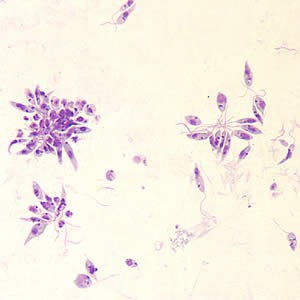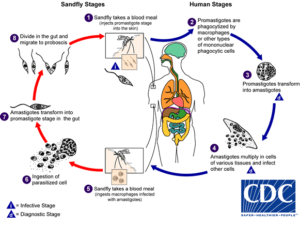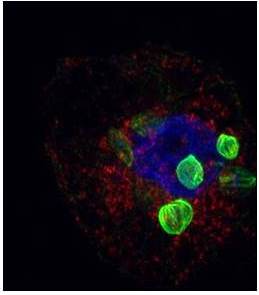
The 6th World Congress on Leishmaniasis (WorldLEISH 6) was the first conference I attended as a fully-fledged scientist (PhD complete and first post-doc underway). I attended primarily to present my research, but also to learn more about this new organism that I have begun to work on: Leishmania.

I couldn’t have picked a better located conference. Set in the UNESCO World Heritage city of Toledo, Spain, a mere 30-minute train ride south of Madrid, the scenery was stunning. The choice of location took on a new level of poignancy when I learnt that a Madrid suburb had suffered from a recent outbreak of leishmaniasis – unusual in this region.
But what is leishmaniasis, and why did this conference cause over 1500 scientists to descend on this small hilltop city?
Leishmaniasis
Leishmaniasis is a neglected tropical disease that is caused by the protozoan parasite Leishmania. Different species of the Leishmania parasite cause different diseases.

One form, cutaneous leishmaniasis, manifests as painful lesions that will heal by themselves, but leave disfiguring scars. Another form, visceral leishmaniasis, targets the liver and spleen and is fatal if not treated. With an estimated 350 million people at risk from leishmaniasis, this disease is a significant health concern. Consequently, the World Health Organisation set a goal of eliminating visceral leishmaniasis in the Indian subcontinent by 2020. With this deadline fast approaching, WorldLEISH 6 provided a timely and much needed platform for scientists to inform and update the rest of the community.
The Meeting
WorldLEISH 6 was an intensive, fully packed conference with plenary lectures, parallel sessions, satellite symposiums, 220 oral presentations and an average of 270 posters per day (!). It was an incredible feat of organisation and planning. However, as this conference only occurs every 4 years, it is not surprising that all scientists working on this parasitic infection wanted to attend. Because of the packed schedule, this post will only focus on a few key areas that made the largest impact on me.
Leishmaniasis and Global Conflict
The first of these was a session dedicated to discussing the implications of global conflicts on the incidence and transmission of leishmaniasis. This session hosted three excellent speakers, each of whom presented a case study on three separate conflicts. Ivan Velez (PECET, University of Antioquia) focused on Colombia and the conflict arising between government and guerrilla forces. Mounir Lado (IMA World Health) presented on the civil war in South Sudan, and Alice Cowley (Mentor Initiative) spoke about the war in Syria. Leishmaniasis in Syria has been reported in the media in the last couple of years, helping to bring this neglected tropical disease into the public eye.
There are several reasons why conflict is beneficial for the Leishmania parasite. One such reason is that a breakdown in government-run refuse collection services causes a build-up in waste. This provides optimal breeding grounds for sand-flies, the vector that transmits the Leishmania parasite to humans. This leads to an increase in transmission, and an increase in the number of cases. In a war-torn country, medical care is difficult to access for all conditions, including leishmaniasis. However, as highlighted in this session, there are a number of humanitarian organisations that work in these incredibly difficult environments to assist people. These organisations, such as IMA World Health, The Mentor Initiative and KalaCORE, work with communities and governments to provide treatment and training.
Photo exhibition
The second area that struck a chord with me was a photo exhibition on leishmaniasis that was open to the public. As the UK is not an endemic region, I do not have first-hand experience of the devastating effect this disease can have on patients, families and communities. As the saying goes “a picture is worth a thousand words”, and each image depicting what patients and their families go through to obtain treatment is quite astonishing. Some trek miles to the nearest healthcare facility and families will often stay with the patient for the duration of the treatment, which can take up to 30 days. These images also showed the facilities that the scientists and physicians have to work in, in order to diagnose and treat people in rural villages.
My perspective
I am a UK-based scientist, and I’m used to working with high calibre equipment.

The frontline staff in these remote facilities are (in my opinion) incredible. They diagnose parasitic infections by looking for parasites in blood smears and aspirates from bone marrow or spleen, in places with intermittent electricity and very little privacy. Molecular techniques, such as polymerase chain reaction (PCR), are more accurate, but they are expensive and require specialist personnel/training, and are therefore not practical in their current form. Research is underway to develop diagnostic tools that are practical for use, and one such example is loop-mediated isothermal amplification, which is explained in this video.
The 6th World Congress on Leishmaniasis was a fantastic conference to attend, with events that informed both the scientists working on this parasitic disease and the general public. Four years is some time to wait for the next one, but I’m already looking forward to it.

Comments